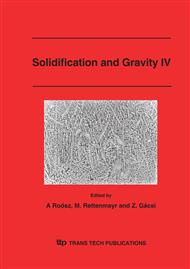p.349
p.361
p.367
p.373
p.379
p.385
p.393
p.405
p.411
Effects of Liquid Core Reduction during Solidification of Pb2.5wt%Sb Thin Slabs
Abstract:
The influence of thickness reduction during solidification of Pb2.5wt%Sb thin slabs in the microstructure was experimentally analyzed using a physical simulator consisted of a water cooled mould with a moveable sidewall, driven by a hydraulic piston, to squeeze the liquid core during the solidification. Experiments were carried out in order to obtain slabs without thickness reduction and with thickness reduction of about 20% and 40%. The microstructures are revealed in order to analyze the influence of the thickness reduction applied in the formation of central equiaxial structure and in the secondary dendrite arm spacing. From the results it was observed that increasing the thickness reduction increases the extension of the equiaxial structure.
Info:
Periodical:
Pages:
379-384
Citation:
Online since:
March 2006
Authors:
Keywords:
Price:
Сopyright:
© 2006 Trans Tech Publications Ltd. All Rights Reserved
Share:
Citation:


